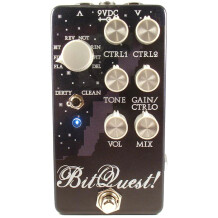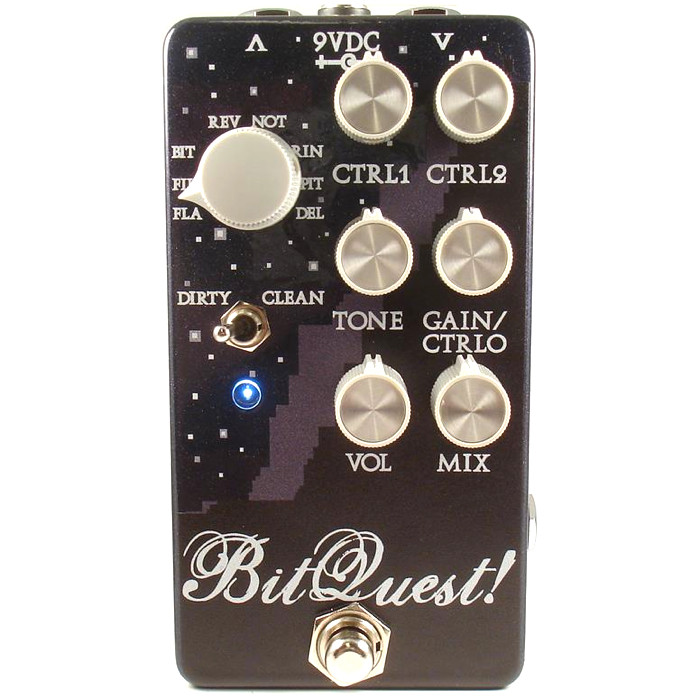Not satisfied with those reviews?
Filter
Our members also liked:
5.0/5(1 reviews)
100 %
Write a user review
Users reviews
 MGR/Brian Johnston
MGR/Brian JohnstonDozens of sounds for multiple patches - a tweakers dream!
Published on 07/16/18 at 06:511 photoSOUND:
Below is a YouTube video that demonstrates some multi-layering of tracks while using each of the patches or effects:
Many of the patches are very unique in what they offer or can offer (as you turn knobs you get very different results). An example is the Ring Modulator, which actually sounds good and is usable. I’m not a fan of Ring Modulators… never could find a use for them because they often sound like fingernails on a chalkboard to my ears. This one is different, as are the other effects. As with the Flanger, which can produce typical flange-type sounds (obviously), you also can achieve some unique chorus…Read moreSOUND:
Below is a YouTube video that demonstrates some multi-layering of tracks while using each of the patches or effects:
Many of the patches are very unique in what they offer or can offer (as you turn knobs you get very different results). An example is the Ring Modulator, which actually sounds good and is usable. I’m not a fan of Ring Modulators… never could find a use for them because they often sound like fingernails on a chalkboard to my ears. This one is different, as are the other effects. As with the Flanger, which can produce typical flange-type sounds (obviously), you also can achieve some unique chorus sounds and modulating comb filter effects. Likewise, the Reverb can sound sinister and ominous on some settings, and the Delay has its own creepiness about it. I’ll address the other effects later, but you also get High and Low Pass Filters, a Notch Filter, a Bit Crusher and Octave Pitch Shifter/Harmonizer. And if that’s not enough you can play clean (your guitar’s original signal) or flip a switch for the built-in Fuzz, which can range from lo-fi to fat and chunky, depending on the settings among the various patches.
OVERALL IMPRESSION:
There is so much to like about this pedal, a Swiss Army Knife with several patches and dozens of tonal possibilities offering hours of investigation and experimentation. It would be cool to utilize more than one patch at a time, but then we’re getting into digital territory and defeats the BitQuest’s footprint (and price tag). What’s is most impressive is the sound and quality of each patch or effect, which stands apart from what you typically hear as a flanger, bit crusher, or even a reverb. The ability to tweak various knobs (and that the knobs can ‘mean’ something different whether playing clean or if engaging the built-in fuzz/distortion) can produces such a wide array of possibilities that the BitQuest has become an obvious ‘most popular’ Dr. Scientist pedal.
BitQuest is an eye-catching pedal, with one half boasting a sparkle paint that is reminiscent of deep space and its stars (with two black knobs), whereas the remainder of the pedal involves two color zones with matching knobs (pink paint with pink knobs and purple paint with purple knobs). You can’t miss this on a pedal board.
EASE OF USE:
Those who want a simple plug ‘n play type pedal should avoid the BitQuest, but those who want a lot of tools, sounds, effects and a greater potential for diverse music composition will not be disappointed. There is so much possible tweaking with this pedal, and in that regard BitQuest literally is addictive to a gear junky.
The Mix knob is not overly sensitive until you get past 12 noon (when you really start to hear an effect). It’s around 2-3 o’clock that you get anequal mix of both the guitar’s signal and the effect. Up full and you may start to salivate! The Fuzz/Clean switch is obvious, although how it affects each patch can differ. For example, when using a clean signal Control Knob 2 sets the delay time of the delayed signal giving you the flanger effect. Conversely, when using the Fuzz, Control Knob 2 controls the flanger level. And so there is a learning curve to BitQuest and it may be helpful to write down settings when you happen upon something cool. Fortunately, Dr. Scientist not only provides full descriptive details of each patch, but also a quick reference Control Guide for your deep-space travels so that you know what Control 0, Control 1 and Control 2 does with a particular effect (e.g., Flanger, Reverb, Bit Crusher, etc.) and whether playing Clean or with Fuzz.
One thing to note about the BitQuestnote is that when you switch from Clean to Fuzz (or vice versa) the opposite does not click in automatically. For example, say you are using the Reverb with a Clean signal and you want Fuzz. You have to click off Reverb (to a different patch effect), flip on the Fuzz and then dial back to Reverb. It sounds a bit glitchy at first, but it’s not a big deal when you’re used to it.
RELIABILITY & DURABILITY:
Dr. Scientist has a great reputation in the pedal industry, for producing quality products, but also products that last. Typical of most pedals is the steel outer casing with very decent looking paint quality. The ‘mini’ on and off ‘soft’ foot switch (no hard clicking) sits on the very edge of the front of the pedal, to provide some clearance for the knobs and Fuzz/Clean switch. The Fuzz/Clean switch sits back from two of the knobs (Volume and Mix), which offers it some good protection. The knobs are plastic, but of a decent quality. All the connections are in the back, which not only saves on pedal board space, but keeps the inputs and cables from harm’s way. Lastly, BitQuest does not run on batteries, but its advanced circuitry allows you to utilize a 9-18VDC power supply.
See less00






